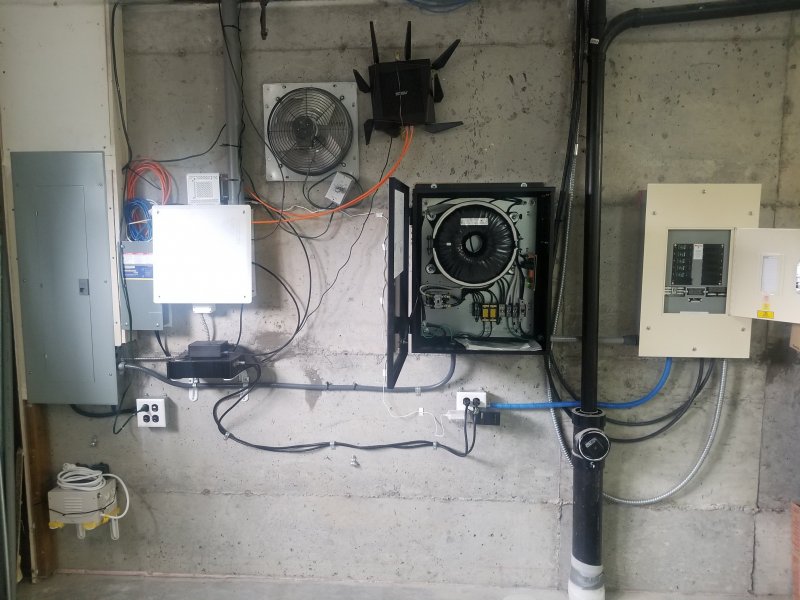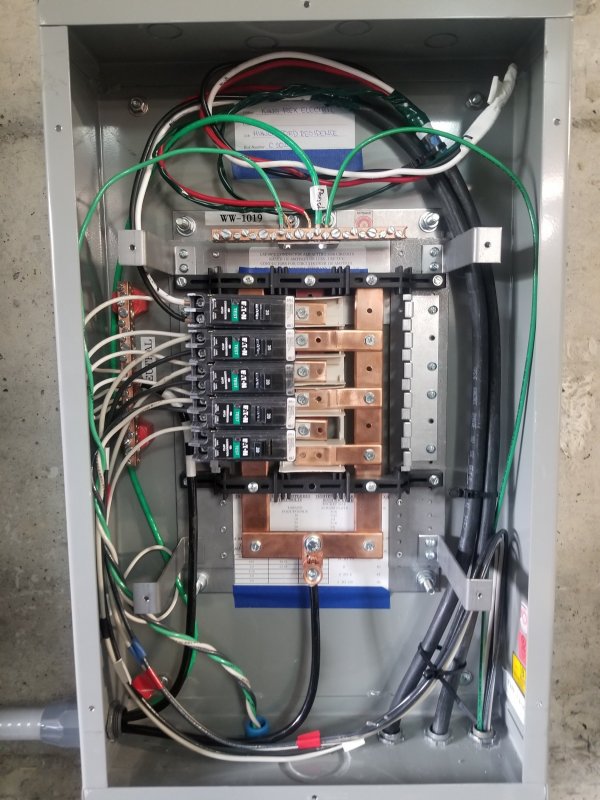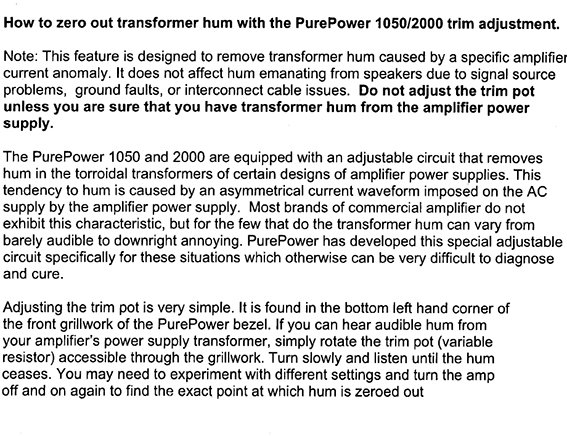As some background for those that don't know, I am an electrician/Audiophile. I spent 6 years developing my understanding of how the electrical infrastructure of you home influences playback. For the last 2 years it has been an intense focus and my sole business.
I perceive tho art highly insightful and intelligent. There are some who've been dabbling in this hobby for 40+ years who still haven't a clue. For you to attain this understanding in 6 short years is rather remarkable and you are to be commended for your willingness to think outside the box.
I have seen a lot of systems and I am fully cognizant the impact proper electrical infrastructure is to audio performance.
Well, not quite yet fully cognizant. First of all and like anything else, there are superior and inferior means and methods, etc. toward a superior electrical mgmt system. The AC power infrastructure you mention only gets us about halfway there. That's addressing the noisy/dirty AC coming in from the street all the way to the components. The other half is addressing the electrical input signal flow as it travels internally throughout the components all the way to the speaker drivers, right?
Besides, I recall you mentioning line conditioners in a very negative way not too long ago. And though you're correct to some extent in that it seems the majority of line conditioners are inferior - implying they either do nothing or induce their own sonic harm, there still are a few superior line conditioners that IME are fabulous performers.
This last weekend was the first audio show I was a vendor at. I had a table in the Market at the Pacific Audio Festival. Being so new to shows it was a fun and exciting time meeting so many great people in the industry. Most every vendor I was chatting with got exactly what I am doing. They understand reproduced music is fundamentally a product of the power from the wall that is shaped by the equipment on the rack. But I was a bit shocked how many people I spoke with, after a minute or so were very nice and said the same exact line. What A Neat Idea. It really shocked me that so many people are unaware the importance of the electricity that feeds their system. And I think those that made the comment, blissfully walked away still unaware.
That's good to hear because it seems most enthusiasts rarely stray from the status quo and until now anything in the electrical mgmt sector has been deemed an accessory.
In all truth, when I bough my first high end piece of equipment 6 or 7 years back, I didn't think about the influence the power in the wall had. I only became aware because the toroid in my amp hummed so loud at times, it was heard in the next room. Then other times it was quiet. I questioned the dealer who sold me the equipment and he shared with me a quote an electrician put together for one of his customer where he was adding dedicated runs and dropping ground rods. That was what got me interested in best practices on feeding highly sensitive amplifying equipment.
Again good to hear. Though I think it worth noting that dedicated circuits/lines actually do little/nothing to cleanse/purify the noisy AC as they really just dedicate the noisy/dirty AC. Sure they might help a tad to minimize noise from dimmers, appliances, digital equipment, etc, but generally it's impact is quite minimal.
The real benefits of dedicated circuits/lines can be narrowed down to exactly two. 1) Sharing anything AC whatsoever with a high-current-drawing amplifier will rob the amp of the juice needed for complex / dynamic passages. 2) Anything digital like a DAC, CDP, etc will induce a bi-directional digital noise. Implying this noise will go back up the power cable into the wall and induce its sonic harm into other components. Some experts have said this bi-directiona digital noise will go all the way back to the service panel and then out to other circuits/lines and I don't doubt that. Though I'm speculating that the digital noise may diminish a bit if it first has to go back to the service panel.
Number 2 also includes Class D amps. Though Class D amps are not digital, their high-speed switching modules will also induce a bi-directional digital-like noise seemingly identical to that of digital. Hence, dedicated circuits/lines could offer some relief here as well. But like anything else they really benefit from some form of superior ilne conditioning.
In my case, I use what I consider superior passive, dedicated, and bi-directional filtering line conditioners on every component. So I really have no need for dedicated circuits/lines even though I have 4 and use them and I also employ a pair of Class D monoblock amps each with their own line conditioner. Note: I probably would not bother with Class D monoblock amps if I did not have superior dedicated line conditioners attached. But I would never consider owning a Class D stereo amplifier because this bi-directional digital-like noise is shared at the common AC inlet. Then again, and getting back to your OP, if my superior line conditioners were taken away and I could not replace them, I've no doubt I'd walk away from the hobby.
So dedicated lines are beneficial for high-currentl-drawing amps and to separate analog from digital components to minimize the sharing of bi-directional digital noise. But superior types of AC cleaning/purifying is still a requirement and it helps if they are bi-directional filtering.
I hope more audiophile in the US start to grasp the importance of power.
I'd give most about 47 more years.

It truly is the most important component in your audio system. It is a global component that affects everything. If its wrong, everything is wrong. If its code compliant but not optimized, it is holding back the equipment on your rack from reaching its full potential.
It truly is indeed. To the best of my knowledge, the playback system's noise floor threshold is determined almost entirely by the quality of AC coming in from the street as well as the quality of electrical current flowing everywhere internally to every component. That's why it doesn't matter how much bling a component has but rather how well the designer acknowledges the existence of this dirty AC and if they've applied superior as opposed to inferior remedies to absolutely minimize the problem..
Another thing. In high-end audio we have two sides of the fence, electrical and mechanical/acoustical as evidenced by the electrical inputs on one side of the speaker drivers and a mechanical/acoustical output as evidenced by the driver diaphragm on the other side.
For the electrical side, I'd venture roughly 90% of the overall quality of musicality we hear can be directly attributed to the quality of AC/electrical current flow. That's how much I think you're on the right path.
There are also numerous other things to consider regarding superior forms of electrical mgmt. Just one example. Cryogenically treating every cable, fuse, plug, outet, inlet, etc that is reasonably possible. And not just any method of cryo-treating but the superior full-immersion method as opposed to the more common but inferior vapor method. When done right, these items are no slouch performance-wise. In fact, if any of these items I just listed are not already cryo-treated or if I think they could be damaged during the process if I ship them out for cryo-treating, I won't buy them. The difference is not insigificant by any means. Even the 12ga and 14ga romex runs I use for my 4 dedicated lines were all double-cryo-treated (regrettably the inferior vapor method) before installing in my remodeled listening room. I used to have everything double-cryo treated until I was introduced to the benefits of the full-immersion method. As one cryo-expert said, the difference between the vapor and full-immersion methods is like eating half-baked cookies.
To the best of my knowledge, nobody is or ever will be fully cognizant of all the benefits of superior electrical mgmt. But really nothing else in the playback vineyard matters much in comparison. Well, except for establishing a superior acoustically coupled speaker/room interface. And as great as those benefits are, that is still a distant second in comparsion to superior electrical mgmt on the electrical side.
Anyway, you are to be commended for your level of understanding and comprehension when so many seem out to lunch.









